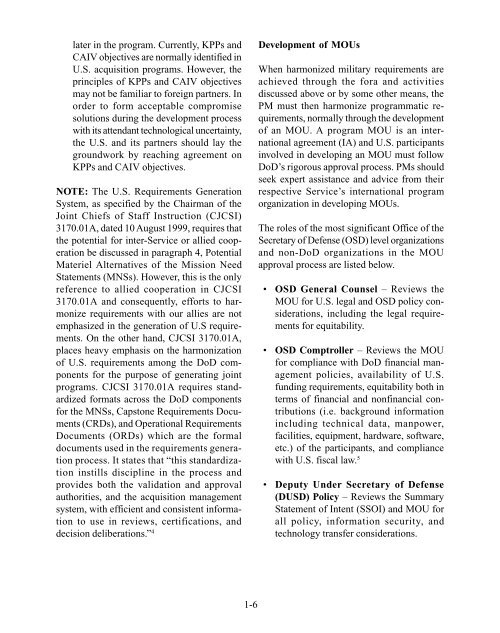Transatlantic Armaments Cooperation - Federation of American ...
Transatlantic Armaments Cooperation - Federation of American ...
Transatlantic Armaments Cooperation - Federation of American ...
You also want an ePaper? Increase the reach of your titles
YUMPU automatically turns print PDFs into web optimized ePapers that Google loves.
later in the program. Currently, KPPs and<br />
CAIV objectives are normally identified in<br />
U.S. acquisition programs. However, the<br />
principles <strong>of</strong> KPPs and CAIV objectives<br />
may not be familiar to foreign partners. In<br />
order to form acceptable compromise<br />
solutions during the development process<br />
with its attendant technological uncertainty,<br />
the U.S. and its partners should lay the<br />
groundwork by reaching agreement on<br />
KPPs and CAIV objectives.<br />
NOTE: The U.S. Requirements Generation<br />
System, as specified by the Chairman <strong>of</strong> the<br />
Joint Chiefs <strong>of</strong> Staff Instruction (CJCSI)<br />
3170.01A, dated 10 August 1999, requires that<br />
the potential for inter-Service or allied cooperation<br />
be discussed in paragraph 4, Potential<br />
Materiel Alternatives <strong>of</strong> the Mission Need<br />
Statements (MNSs). However, this is the only<br />
reference to allied cooperation in CJCSI<br />
3170.01A and consequently, efforts to harmonize<br />
requirements with our allies are not<br />
emphasized in the generation <strong>of</strong> U.S requirements.<br />
On the other hand, CJCSI 3170.01A,<br />
places heavy emphasis on the harmonization<br />
<strong>of</strong> U.S. requirements among the DoD components<br />
for the purpose <strong>of</strong> generating joint<br />
programs. CJCSI 3170.01A requires standardized<br />
formats across the DoD components<br />
for the MNSs, Capstone Requirements Documents<br />
(CRDs), and Operational Requirements<br />
Documents (ORDs) which are the formal<br />
documents used in the requirements generation<br />
process. It states that “this standardization<br />
instills discipline in the process and<br />
provides both the validation and approval<br />
authorities, and the acquisition management<br />
system, with efficient and consistent information<br />
to use in reviews, certifications, and<br />
decision deliberations.” 4<br />
1-6<br />
Development <strong>of</strong> MOUs<br />
When harmonized military requirements are<br />
achieved through the fora and activities<br />
discussed above or by some other means, the<br />
PM must then harmonize programmatic requirements,<br />
normally through the development<br />
<strong>of</strong> an MOU. A program MOU is an international<br />
agreement (IA) and U.S. participants<br />
involved in developing an MOU must follow<br />
DoD’s rigorous approval process. PMs should<br />
seek expert assistance and advice from their<br />
respective Service’s international program<br />
organization in developing MOUs.<br />
The roles <strong>of</strong> the most significant Office <strong>of</strong> the<br />
Secretary <strong>of</strong> Defense (OSD) level organizations<br />
and non-DoD organizations in the MOU<br />
approval process are listed below.<br />
• OSD General Counsel – Reviews the<br />
MOU for U.S. legal and OSD policy considerations,<br />
including the legal requirements<br />
for equitability.<br />
• OSD Comptroller – Reviews the MOU<br />
for compliance with DoD financial management<br />
policies, availability <strong>of</strong> U.S.<br />
funding requirements, equitability both in<br />
terms <strong>of</strong> financial and nonfinancial contributions<br />
(i.e. background information<br />
including technical data, manpower,<br />
facilities, equipment, hardware, s<strong>of</strong>tware,<br />
etc.) <strong>of</strong> the participants, and compliance<br />
with U.S. fiscal law. 5<br />
• Deputy Under Secretary <strong>of</strong> Defense<br />
(DUSD) Policy – Reviews the Summary<br />
Statement <strong>of</strong> Intent (SSOI) and MOU for<br />
all policy, information security, and<br />
technology transfer considerations.
















